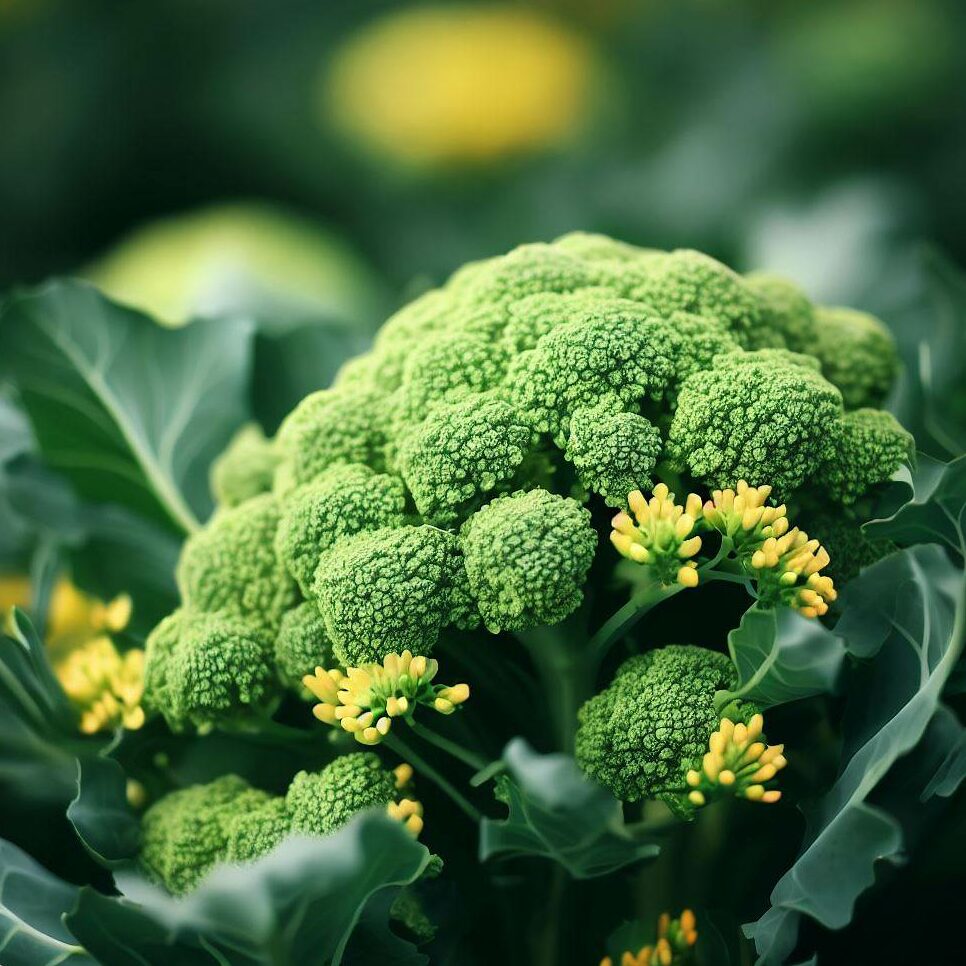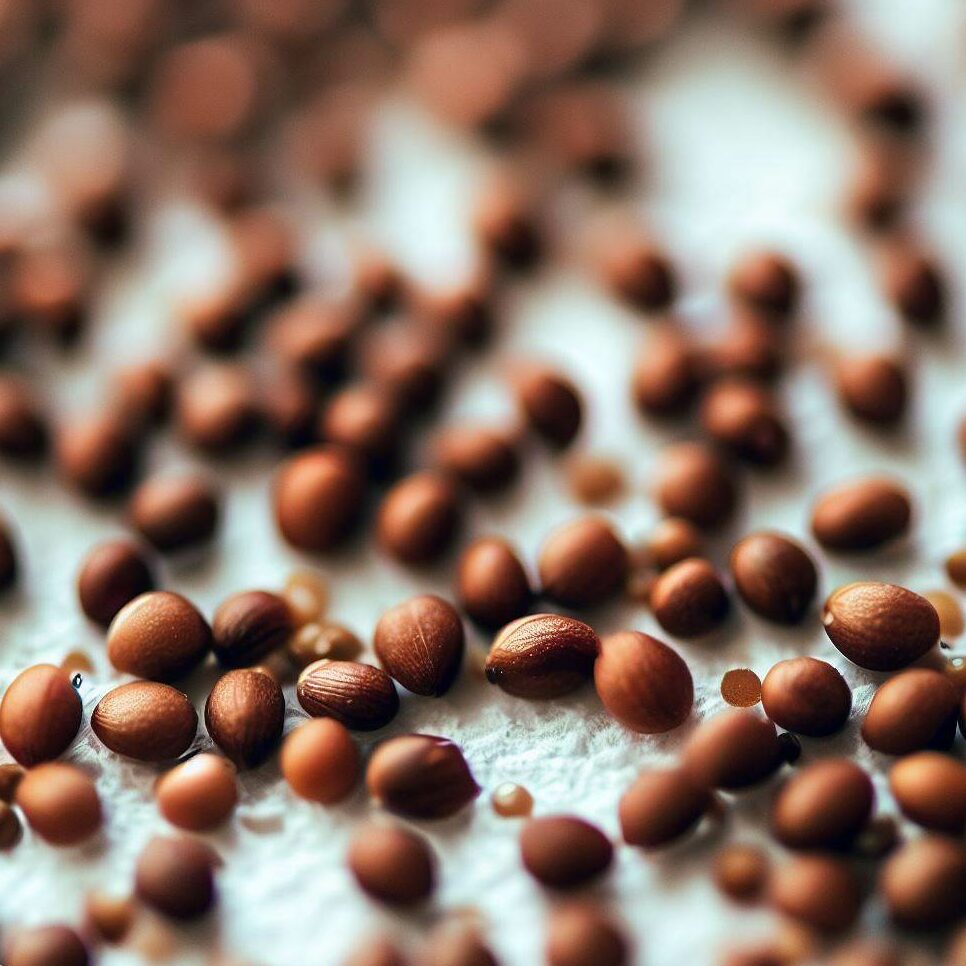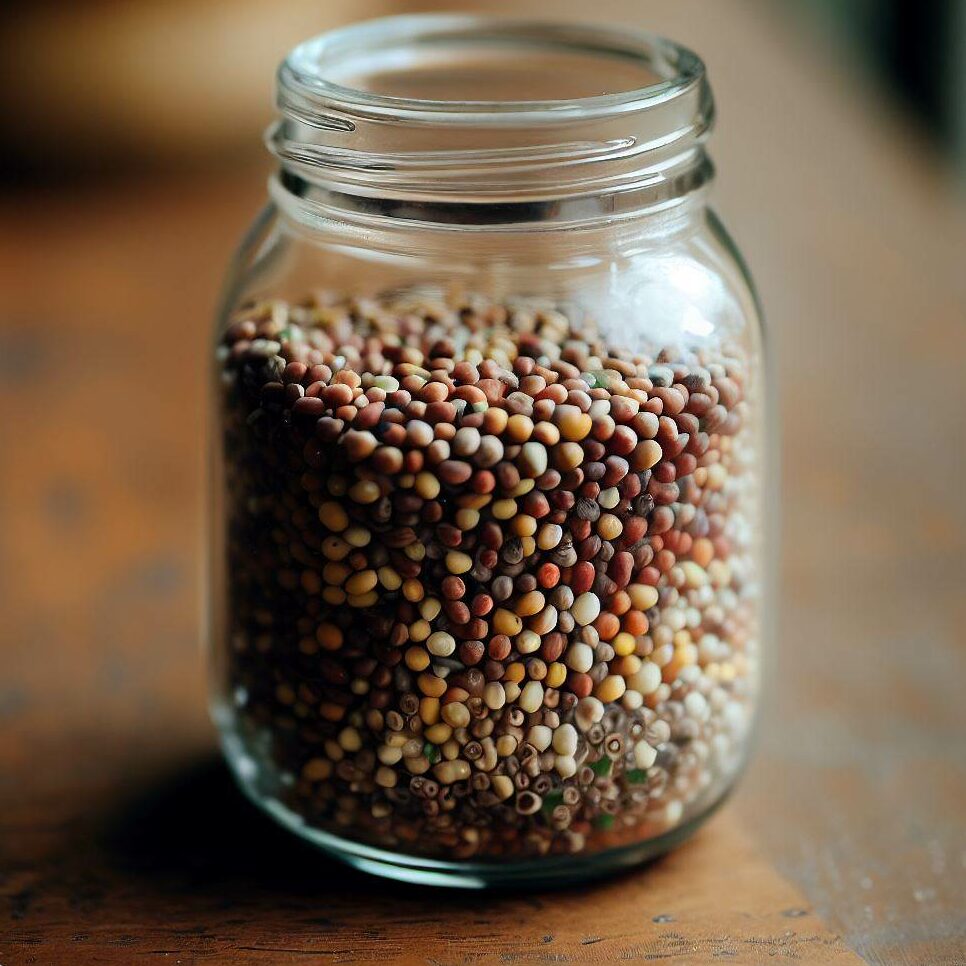Welcome to the wonderful world of harvesting broccoli seeds. If you’ve ever marveled at the lush green heads of broccoli in your garden and wondered how you could replicate that success, you’re in the right place. This guide will take you on a journey from the heart of your broccoli plant to the bountiful harvest of seeds that await you.
Harvesting broccoli seeds involves waiting until the plant’s flowers have bloomed and dried out, turning into seed pods. These pods, usually brown or tan, contain the seeds. Cut the stalks with the seed pods and let them dry further indoors for a couple of weeks. Once dry, you can open the pods to collect the seeds. Store the seeds in a cool, dry place and they can remain viable for up to five years.

Remember, the magic of gardening lies in the seeds. By saving and harvesting your own broccoli seeds, you’re not just growing a plant; you’re preserving a legacy of bountiful harvests for seasons to come.
So, whether you’re a seasoned gardener or a curious beginner, this guide will equip you with the knowledge and confidence to embark on the rewarding journey of harvesting your own broccoli seeds. Let’s dive in and let the green thumbs do the talking!
Understanding Broccoli and Its Lifecycle
Before we delve into the specifics of harvesting broccoli seeds, it’s essential to understand the lifecycle of a broccoli plant. This journey, from seed to plant and back to seed, is a fascinating process that showcases the wonders of nature.
The Journey Begins: From Seed to Sprout
It all starts with a tiny broccoli seed. When planted in fertile soil and given the right care, this seed sprouts into a seedling. This is the first stage of the broccoli plant’s lifecycle.
🌿 Broccoli Brief: Broccoli prefers cooler temperatures, so it’s best to start your seeds indoors 6-8 weeks before the last expected spring frost. 🌿
From Sprout to Mature Plant
As the seedling grows, it develops into a mature plant with large, green leaves and a thick, edible stem. The highlight of this stage is the formation of the broccoli flower head, which is actually a cluster of immature flower buds.
The Seed Stage
If you allow the broccoli flower head to mature and bloom, it will produce yellow flowers. These flowers, through the process of broccoli pollination, eventually give way to seed pods, marking the final stage of the lifecycle. So, to answer the question, “What part of the broccoli is the seed?” – it’s the pods that form after the flowers bloom.
🌿 Broccoli Brief: Yes, broccoli does have seeds! They are found in the slender, green pods that develop after the flowers bloom. Each pod contains several small, dark seeds.
Understanding this lifecycle is crucial for successful broccoli seed harvesting. It helps you identify the right time to harvest the seeds and gives you a deeper appreciation for the miracle of growth that happens in your garden.

When and How to Harvest Broccoli Seeds
Now that we’ve explored the lifecycle of a broccoli plant, it’s time to delve into the main event: harvesting broccoli seeds. But how do you know when your broccoli is ready for seed harvesting, and how do you go about it? Let’s find out.
Identifying the Right Time for Harvesting
The first step in harvesting broccoli seeds is knowing when to do it. The key sign to look for is the color of the seed pods. When the pods on your broccoli plant turn from green to a straw or brown color and become brittle to the touch, it’s time to harvest the seeds.
🌿 Broccoli Brief: Patience is key when it comes to harvesting broccoli seeds. Harvesting too early can result in immature seeds that won’t germinate, so it’s important to wait until the pods have fully matured and dried on the plant. 🌿
Step-by-Step Guide to Harvesting Broccoli Seeds
So, how do you harvest broccoli seeds? Follow these steps:
- Wait for the seed pods on your broccoli plant to turn brown. This indicates that the seeds inside are mature and ready for harvesting.
- Once the pods are dry and brittle, it’s time to harvest. You can either pull the entire plant from the soil and allow the pods to dry further on the stalk, or you can cut the stalks and let the pods dry indoors.
- After the pods have dried, you can remove the seeds. One method is to shake the pods in a paper bag, which will cause the dry pods to break open and release the seeds.
- Once you’ve collected the seeds, allow them to dry thoroughly before storing them. This will prevent mold and ensure the seeds remain viable for future planting.
How Long Does It Take to Dry Broccoli Seeds?
Drying times can vary depending on the humidity and temperature of your area, but generally, it takes about two weeks for broccoli seeds to dry thoroughly. It’s important to store the seeds in a cool, dry place to prevent mold and maintain their viability.
🌿 Broccoli Brief: Label your seed packets with the date and variety of broccoli to keep track of your seed collection. This will be helpful when it’s time to plant next season! 🌿
Harvesting broccoli seeds may seem like a meticulous process, but it’s a rewarding one. With patience and care, you can collect a bounty of seeds for your next planting season, ensuring a continuous supply of this nutritious vegetable in your garden.
Post-Harvest: Drying, Storing, and Viability of Broccoli Seeds
Harvesting broccoli seeds is just the first step in the process. What comes next is equally important: drying and storing the seeds properly. This ensures that your harvested seeds remain viable and ready for the next planting season.
The Importance of Drying Broccoli Seeds
After harvesting, the broccoli seed pods need to be thoroughly dried. This is crucial because any moisture left in the seeds can lead to mold growth, which can ruin your entire seed batch. Drying also prepares the seeds for storage and helps maintain their viability.
🌿 Broccoli Brief: Spread your harvested seeds out in a single layer on a paper towel or a screen to dry. Make sure they’re in a well-ventilated area away from direct sunlight. 🌿
Storing Broccoli Seeds
Once your seeds are dry, it’s time to store them. Proper storage is key to maintaining the viability of your seeds. Store your seeds in a cool, dry place away from direct sunlight. You can use paper envelopes or glass jars for storage. Remember to label your containers with the seed variety and the date of harvest.
🌿 Broccoli Brief: Using silica gel packets in your storage containers can help absorb any residual moisture and keep your seeds dry. 🌿

How Long Are Broccoli Seeds Viable?
So, how long are broccoli seeds viable? With proper storage, broccoli seeds can remain viable for up to five years. However, it’s important to note that the germination rate (the percentage of seeds that will successfully sprout) may decrease over time. Therefore, it’s a good practice to plant your seeds within a year or two of harvesting for the best results.
In conclusion, the process of harvesting broccoli seeds doesn’t end with the collection of seeds. Proper drying and storage are crucial steps that ensure your hard work pays off when it’s time to plant the next season. Happy gardening!
The Benefits and Uses of Broccoli Seeds and Sprouts
Harvesting broccoli seeds isn’t just about preparing for the next planting season. There’s more to these tiny seeds than meets the eye. In fact, broccoli seeds and sprouts are packed with health benefits and can be used in various ways in your kitchen.
Health Benefits of Broccoli Sprouts and Seeds
Broccoli sprouts and seeds are nutritional powerhouses. They’re rich in vitamins A, C, and E, calcium, and fiber. But the real star of the show is a compound called sulforaphane, which has been linked to numerous health benefits, including:
- Boosting heart health
- Supporting brain health
- Enhancing detoxification
- Supporting healthy digestion
- Promoting skin health
🌿 Broccoli Brief: Sulforaphane levels are particularly high in broccoli sprouts. In fact, broccoli sprouts can contain up to 100 times more sulforaphane than mature broccoli! 🌿
Can I Eat Raw Broccoli Seeds and Are Broccoli Seed Pods Edible?
Yes, you can eat raw broccoli seeds and broccoli seed pods. They’re not only edible but also nutritious. However, they have a strong, somewhat bitter taste that some people may find off-putting. To make them more palatable, you can try sprouting the seeds.
Sprouting Broccoli Seeds in a Jar
One of the most popular uses for broccoli seeds is to sprout them. Sprouting broccoli seeds in a jar is a simple process that can be done at home. The sprouts can be used in salads, sandwiches, or as a garnish for various dishes. Plus, sprouting increases the bioavailability of nutrients, making seeds for broccoli sprouts a nutritious addition to your diet.
🌿 Broccoli Brief: When sprouting seeds, make sure to rinse them thoroughly and often to prevent mold growth. It usually takes about a week for broccoli seeds to sprout. 🌿
In conclusion, broccoli seeds and sprouts offer a wealth of health benefits and culinary uses. So, the next time you harvest broccoli seeds, remember that you’re not just harvesting for the next planting season, but also for a healthier, more nutritious diet.

Dealing with Common Broccoli Growing Issues
While broccoli is a rewarding plant to grow, it’s not without its challenges. Two common issues that gardeners often encounter are bolting and flowering. But don’t worry, we’ve got you covered with solutions to these problems.
Bolting: Can You Harvest Broccoli After It Bolts?
Bolting is a process where a plant prematurely goes to seed, often due to high temperatures. When broccoli bolts, it sends up a flower stalk and stops producing edible heads. So, can you harvest broccoli after it bolts? The answer is yes, but with a caveat. The taste of bolted broccoli can be bitter, and the texture tough. However, you can still harvest the seeds for future planting.
🌿 Broccoli Brief: To prevent bolting, try to plant broccoli early in the spring or late in the summer for a fall harvest. Broccoli prefers cool weather and will bolt in hot conditions. 🌿
Flowering: What to Do with Broccoli After It Flowers?
If your broccoli has flowered, it means it has completed its life cycle and is ready to produce seeds. At this stage, the broccoli heads are usually past their prime for eating, but you can still harvest the seeds. This is also the answer to the question, “what to do when broccoli goes to seed.”
Why Did My Broccoli Go Straight to Seed?
If your broccoli went straight to seed, it’s likely due to stress from unfavorable growing conditions, such as extreme temperatures, inadequate water, or poor soil. To prevent this, ensure your broccoli has a well-drained, fertile soil, regular watering, and protection from extreme weather.
🌿 Broccoli Brief: Even if your broccoli goes straight to seed, all is not lost. The seeds contain sulforaphane, a compound with numerous health benefits. In fact, broccoli seeds can have higher concentrations of sulforaphane than mature broccoli. 🌿
In conclusion, while growing broccoli can have its challenges, understanding these common issues and how to deal with them can help you have a successful harvest. And remember, even if things don’t go as planned, you can still benefit from the nutritious seeds your broccoli plant produces.
In this video, Chad Cruisers from Health and Homestead shares his expert knowledge on harvesting broccoli seeds. He takes viewers through the entire process, from understanding the lifecycle of broccoli to the actual harvesting of the seeds. Chad also discusses the importance of maintaining genetic diversity in your crops and provides practical tips on how to achieve this. This video is a must-watch for anyone interested in sustainable gardening and seed saving. It’s not just about harvesting broccoli seeds, but also about understanding the beauty and intricacies of nature.
Conclusion: The Joy of Harvesting Your Own Broccoli Seeds
Harvesting your own broccoli seeds is a rewarding endeavor that brings numerous benefits. Not only do you get to enjoy the fruits (or rather, seeds) of your labor, but you also gain a deeper understanding of the lifecycle of this versatile plant.
We’ve covered a lot of ground in this article, from understanding the lifecycle of broccoli, knowing when and how to harvest broccoli seeds, to dealing with common growing issues. We’ve also highlighted the health benefits of broccoli seeds and sprouts, and how to properly dry and store your harvested seeds.
🌿 Broccoli Brief: Did you know that a single broccoli plant can produce hundreds of seeds? That’s a lot of potential for future harvests! 🌿
So why not give it a try? Whether you’re a seasoned gardener or a beginner, harvesting broccoli seeds is a skill worth learning. It’s not just about the end result, but also the process itself. There’s something truly satisfying about watching your plants grow from seed to seed, knowing that you’ve nurtured them every step of the way.
